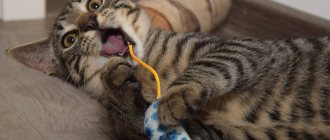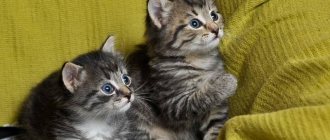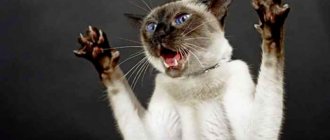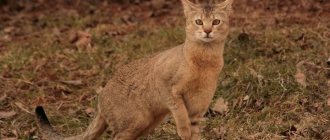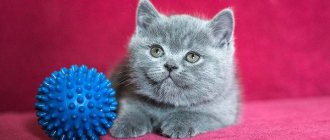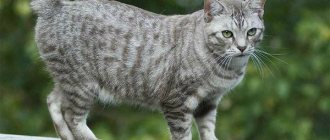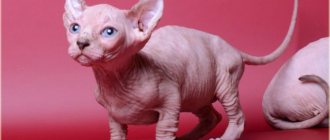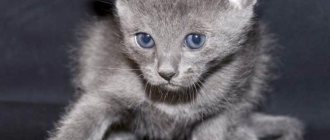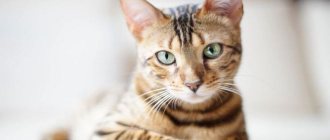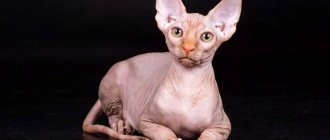History of Pied Pipers
The domestication of cats occurred in Egypt approximately 9 thousand years BC. e. In those days, the grain harvested from the fields was eaten by mice and rats. People saw how cats hunted them and began to lure and tame the nimble hunters. Since then, these animals have taken their place next to people, ridding them of rodents. For such merits, cats were called sacred animals, protecting food supplies and saving people from hunger. Since ancient times, cats have been given special honors, and high fines were imposed for killing them. The cost of a clever rat-catcher cat was equal to the cost of an ox.
Agile rat-catching cats in the old days were worth as much as an ox
There is a legend that says that during the global flood, rodents appeared on Noah’s Ark, dangerous to the inhabitants. Then cats were born from the lions, destroying all the rodents and saving the animals on the ship from them.
Cats conscientiously performed their duties in peasant homes, in monasteries, and at the royal court. Peter I ordered the adoption of cats to protect barns from the invasion of mice and rats. By order of Elizabeth, his daughter, 30 rat-catcher cats were brought to the Winter Palace from Kazan, the city where the most dexterous rat-catchers were believed to live. During the reign of Catherine II, cats appeared in the Hermitage to protect works of art from rodents.
During the siege of Leningrad, cats saved residents and the city itself 2 times. When, in the first years of the siege, all the animals were eaten due to hunger, many rodents appeared in the city, and the Winter Palace was simply swarming with them. To combat dangerous rodents, 5 thousand smoky cats were brought from Yaroslavl to Leningrad in April 1943, then a train of Siberian cats arrived, and soon rodents disappeared from the city.
Cats still regularly serve in the Hermitage, protecting the country’s cultural heritage from rodents and forming an integral part of museum life; they are its unique symbol. Museum employees say that throwing cats out into the street is like throwing a painting by an outstanding artist from the 10th floor.
Cats in the Hermitage protect the country's cultural heritage from rodents
Tailed liberators of Leningrad
When all the cats in the besieged city were eaten in 1943, rats began to multiply at a catastrophic rate. They ran through the streets like a businessman in search of corpses, climbed into apartments, destroyed furniture and the last supplies.
The rodents were shot by special brigades and crushed by tanks, but the “rat troops” did not retreat. The city was saved by rat-catching cats of Russian and Siberian breeds. They were brought in trains from all over the country after the blockade was broken.
Today, two sculptures remind us of the four-legged liberators. One depicts the cat Vasilisa standing on the ledge, the second depicts the cat Elisha sitting opposite. St. Petersburg residents believe that whoever throws a coin on a cat pedestal will be lucky.
The Siberian cat is an obstinate hunter
Nothing is known exactly about the origin of this breed; most likely, it was brought to Russia from Asia. She was nicknamed “Siberian” for her traditional long and fluffy fur. The cat, as you see in the photo, stands out for its strong build (females grow up to 5-7 kg, and males up to 9 kg) and powerful strong paws with excellent grip. In addition, the hind legs are slightly longer, which allows them to jump and run well.
The Siberian beauty has an obstinate character, excellent speed and reaction, which makes her an excellent hunter. Looking at her, you immediately understand that the cat has more than once participated in skirmishes with rodents. The animal is not very attached to humans, walks on its own and values freedom. By the way, to keep fit, your cat needs regular walks in the fresh air.
The only thing known about the origin of the breed is that it was brought from Asia to Russia. The breed got its name due to its fluffy and long coat. Some owners get these animals just for their attractive appearance. However, not everyone knows that this breed is a born rat catcher.
The appearance is characteristic: representatives of the breed have a strong body (the weight of males reaches 9 kg, and females - 7 kg) and strong legs with a strong grip. The hind legs of these animals are longer than the front ones, due to which they are able to develop greater speed in running and also jump well. Siberian cats have excellent reactions. Even from their glance it is clear that they are able to take part in the fight against mice and rats.
The character of these animals is quite obstinate. They do not become very attached to their owner, preferring to walk on their own. Their freedom is very important to these animals. Due to its free-spirited nature, such a cat needs periodic walks outside.
Cat or cat: who is the better hunter?
If we talk about the gender of mousecatchers, it still seems more reasonable to give the palm to the cat. In cats, the sexual instinct comes first, and if the animal is not castrated, the mustachioed cat can be distracted by “love” all year round, neglecting his hunting duties. We have all seen how skinny and tattered the tailed gentlemen return from their sexual adventures - it is obvious that they had no time for mice.
In cats, the estrus period is usually not long. And, raising kittens, as we said above, they hunt with double zeal and teach their offspring to do so. That is, they have double motivation. And female creatures usually have more persistence and diligence.
General features of rat catchers
The rat catcher is not a separate breed of cat, it is the valuable quality of the animal, the sharpness of its hunting instinct. According to felinologists (specialists in breeding cats), rat-catching cats can be identified by the following characteristics:
- muscular body, powerful jaws, strong legs;
- head shape - there is a relationship between the genes responsible for the instincts of hunters and the genes that determine the configuration of the skull of cats: rat-catching abilities are observed in animals with a triangular head (oriental type of cats);
- lush mustache and high ears with tassels at the ends: they allow animals to detect possible rustles, and this is very important for a successful hunt.
Ratcatcher cats usually have large ears that can detect the smallest noises.
Some rat hunters may be affectionate in nature, while others may be unsociable. There are animals that want to please their owner and often catch rats to show him their love. And there are cats that avoid people and do not welcome affection, but this is also quite normal.
By what signs can you recognize a rat catcher?
A mousetrap cat is not a breed, but a rare skill that a pet develops due to the conditions of its keeping and upbringing. The best hunters are considered to be mongrel cats, who have had to hunt mice for food since childhood.
Street animals are not spoiled by the attention and care of the owner, so the hunting instinct develops and remains for the maximum period
The following signs will help you recognize a future rat catcher in a kitten:
- if one of the parents is good at catching mice, by four months the skill will be transferred to the kitten;
- female. Cats catch mice better than cats, which is associated with increased activity and fearlessness. To feed her offspring, the mother cat will get food in any way, so her hunting instinct is heightened;
- head shape. Animals with a triangular oriental skull shape have greater potential for catching rats;
- activity in the game. If a kitten runs after ribbons, toy mice and catches them with his teeth, he will make a good hunter;
- physiological characteristics. The pet must be well built, have developed muscles, strong bones;
- high ears with tassels. Allow the pet to track rustles and squeaks, which increases the likelihood of finding a target;
- color feature. It is believed that the best hunters are tri-colored, tortoiseshell, and motley cats.
The listed signs increase the likelihood of a successful hunt. But the development of the skill depends on the conditions of detention and upbringing. If you keep your pet in an apartment and give it food when called, the hunting instinct will “die out.”
Maine Coon - the terror of all rats
The Maine Coon cat is a strong and agile breed that is resistant to various conditions, so it can live in areas with harsh climates. The cat is stately and large (the male grows up to 15 kg), has a predatory disposition and does not like affection from humans. Due to its size, it easily copes with rodents, so most often it is used by farmers whose farms are threatened by rats and mice. Maine Coons were originally developed as “working cats.”
The true king of the Maine Coon has a long and dense coat of predominantly dark shades (the photo shows the 3 most common colors), well-developed muscles, strong bones and a wide chest. A distinctive feature of the breed is its peculiar, erect, large ears with tassels. The tail is long and thick with flowing hair. All this makes the cat a threat to all rats and mice.
Cat and mouse - a game without giveaways
Catching a rat that is more intelligent than a cat is not easy. In this duel between a predator and a rodent, the winner is unknown. There have been cases when a rat managed to get the better of a cat. Therefore, not all murkas dare to play the deadly game of cat and mouse.
If you notice rat bites on your pet's body, disinfect them immediately. It won't hurt to contact a veterinarian. Timely vaccination will help minimize the risk of infection (the main risk is rabies).
People have long valued cats that can catch and strangle rodents. There is no creature more harmful than a rat, which:
- spreads diseases (the plague epidemic, which claimed 60 million lives in the 14th century, was its work);
- recognizes and adapts to poisons (if an individual survives as a result of deratization, it will avoid the type of pesticide used, and its offspring will become immune to it);
- chews everything in its path, even metal and concrete;
- in a year he can eat 12 kilograms of food and spoil even more.
But the ubiquitous and omnivorous creature has a formidable opponent - the rat-catcher cat. Statisticians have calculated that if it were not for the help of a domesticated predator in the farm, it would feed mainly toothy pests, not people.
Breeds of rat-catching cats
There are certain breeds in the cat family, whose representatives are distinguished by excellent health, special dexterity and dexterity in catching rats.
Siberian cat
The cat was named Siberian due to its fluffy long hair. She is unpretentious, has a strong build, the weight of cats reaches 7 kg, cats weigh about 9 kg. She has strong paws and excellent grip. Due to the slightly longer hind legs compared to the front legs, the cat has the ability to run and jump quickly. Such animals are obstinate in nature, they have an excellent reaction, which is necessary when catching rats. They are independent and love freedom.
The Siberian cat has a strong build and excellent grip.
To maintain the desired shape, Siberian cats require regular walks in the fresh air.
Maine Coon
Cats of this breed are distinguished by mobility and strength. Maine Coons are hardy and able to live in regions with harsh climatic conditions. These large animals (males can weigh up to 15 kg) have the nature of a predator; they do not welcome human affection. Due to their size, they can easily deal with rats.
Maine Coons easily deal with rats
This breed of cat is distinguished by straight-set large ears, which have tassels at the ends. Maine Coons have long and thick fur. They have well-developed muscles, a wide chest, strong bones, and a thick and long tail. All this data allows Maine Coons to become a real threat to rodents.
Kurilian Bobtail
A feature of animals of this breed is a short tail, the length of which does not exceed 3–8 cm. But they have strong hind legs, which are longer than the forelimbs. And therefore the Kurilian bobtail runs well, jumps, and deftly strangles rats. Males of this breed weigh about 10 kg, females - 6 kg.
The Kurilian Bobtail is fearless and deftly strangles rats
Such cats are capable of completely destroying a mouse or rat hole. They are easy to train and can be trained. People keep them as companions; they get along easily with other animals. Bobtails have a fearless character.
European shorthair cat
Representatives of this breed destroyed rodents back in the days of Ancient Rome. European shorthair cats are called yard cats and are not considered purebred. However, they are popular in the world and are one of the best rat catchers. The predator's passion and agility help them successfully hunt rats and mice.
European shorthair cats are some of the best rat catchers.
Such cats are distinguished by individuality, independence, grace, and aristocratic appearance. They have a short coat, gray or silver marbled in color.
European cats get along well with people and are non-aggressive. They love to play, but do not completely obey their owner.
Cymric
Animals of this breed are similar to ordinary cats, but with a short tail. This structure, along with agility and tenacious claws, makes the Cymric a successful rat catcher.
Agility and tenacious claws make the Cymric a successful rat catcher.
It is good to keep these cats in private homes with open areas, as the animals require regular walks in the fresh air, freedom of movement, and physical activity.
British Shorthair
The hunting instinct and excellent natural inclinations make the British excellent rat catchers. Such cats are calm, friendly, and attractive in appearance. They love to please their owner by bringing him a caught rodent in their teeth in order to exchange it for rewards and something tasty.
Natural inclinations and hunting instinct make British Shorthairs excellent rodent catchers.
Females, weighing an average of 4 kg, try not to attack large rats, hunting only young ones or mice. Often this is enough to avoid a rodent infestation.
Russian blue
Russian blue cats are medium in size and light in weight, but this does not interfere with their hunting habits. Instant reaction and silent movement for a long time make these cats good rat catchers.
The Russian Blue cat has the ability to move silently and react instantly.
The ability of the Russian Blue to react to rodents is a true art: its speed of attack on the prey, accuracy and grace of movements are captivating. This is a thunderstorm of super rats, weighing about 500 g. The Russian Blue does not like partners of other cat breeds, but gets along well with rat catchers of its own breed. Opponent of tenderness from the owner.
Cat breeds that can kill rats
There are breeds of cats that are better than others at exterminating rats, an intelligent rodent that is ready to fight back.
Russian blue
The aristocracy of the Russian Blue does not prevent it from being an excellent hunter. The medium-sized, muscular body, flexible and graceful, is in harmony with an excellent reaction that leaves no chance for insects, mice and rats. Royalty favored these cats: Peter the Great had a gray-blue favorite, under Elizabeth Petrovna about 300 four-legged rat-catchers lived in the palace, Catherine the Second presented the royal families of Europe with Russian beauties. Cleanliness and devotion to the owner are characteristic features of the Russian Blue cat.
Maine Coon
One of the largest breeds of domestic cats. The homeland of Maine Coons is Maine (USA). They come from aboriginal cats, which were used to exterminate rodents on ships and on farms. The animal has strong bones, well-developed muscle tissue, a wide chest and straight ears with tufts. Good-natured and balanced, these cats are passionate about hunting.
Easily adapt to different climatic conditions. They love frequent walks.
Siamese cat
Siamese cats originate from the aborigines of the Kingdom of Siam, their origins go back to the distant 13th century. Small, graceful and flexible, the cat has intelligence and a freedom-loving character. Loyal to her owner, she at the same time will not tolerate an authoritarian attitude towards herself. Natural abilities help the Siamese when hunting: quick reaction and the ability to be aggressive at the right moment will not allow the rodents to escape.
Siberian cat
An aboriginal breed that formed in the 16th century, during the period of development of Siberia. Came to Siberia from Asia. Natural conditions forced the cat to grow long, thick hair and develop hunting skills. A large animal with a strong body and a developed sense of smell is capable of destroying a rat. The Siberian can run and jump quickly and has excellent reactions. It is about her that we can say that this is a “cat that walks on its own”: representatives of the breed value freedom and do not experience strong attachment to humans. They feel great in a private home because they love to be in the fresh air.
https://youtube.com/watch?v=20v5dd_gCn4
Cymric
Medium size and the absence of a tail do not prevent the Cymrik from being an excellent hunter. All this is compensated by long and tenacious paws, which allow the cat to catch up and grab prey with a death grip. This animal is characterized by intelligence and loyalty. The pet loves space, so keeping it in a private home is preferable.
British shorthair cat
Stray cats in England gave rise to the British Shorthair breed. Quiet aristocrats, as befits true Englishmen, are distinguished by loyalty and devotion. A medium-sized but muscular body, short, dense, thick hair - this is the appearance of the British woman. Its small size does not prevent it from being a good hunter. Patience and endurance help the cat to track down the prey, and the natural instinct and desire to serve the owner is to catch it.
What cats catch mice and rats
Many owners living in the private sector are specifically looking for mousecatchers. However, identifying them is not always easy. Some rely on genetics. In other words, if the mother was a mousetrap cat, then the kitten will inherit her gift. Another option is breed.
Mousecats are especially needed in private homes
There is no doubt that certain members of the cat family have a greater propensity for catching rats or mice. However, there are other ways to determine which cats are better at catching rats and mice.
How to identify a rat-catcher cat
The first thing you should pay attention to is the color of the animal. Representatives with gray, black, brown, or red skin blend better with nature and, as a result, are more successful hunters. White, unfortunately, in this case, is the most losing.
The second point is education. It is very important how the kitten behaved in childhood. Outdoor games with a bow, a ball, chasing the light of a laser pointer - all this is the preparation and development of hunting instincts.
For your information! Yard cats and female cats are excellent mousecatchers. The point is also that they develop their instincts from childhood. Hunting for them is a way to survive.
An equally interesting question is whether the rat-catcher cat will continue to hunt after castration. The animal's behavior changes after this operation, but this does not mean that it will lose its innate and developed instincts. The only thing you should be careful of in this situation is overfeeding your pet. Such measures often lead to obesity, and, as a result, hunting skills decrease. Therefore, a neutered cat should be given a special diet, so that he will continue to perform the task assigned to him.
By what external signs can one identify a future mousetrap?
It is believed that a cat that can successfully catch mice must look the part. What signs can be used to determine which kitten will be an excellent rodent exterminator?
Signs of a mousecatcher:
- long mustache;
- wild color - black, red or gray, two or three colors, with faint stripes and spots to blend with nature and remain invisible to its prey;
- short hair – long and thick guard hair when wet acquires an unpleasant odor, which can scare away the rodent;
- large ears and triangular head;
- large paws.
They tried to choose the best rat catcher using these signs several decades ago. In reality, there are no perfect rat hunters. Every cat has a hunting instinct from birth, but not all representatives of the feline family realize it with equal success.
Before you take a kitten into your home to catch mice, you should ask whether its mother was a good hunter. When raising their cubs, cats pass on their skills to them, including in catching rodents.
If the pet was taken from the street, it is highly likely that its hunting skills will be well developed. In purebred pets, the instinct is dulled, especially if several generations of animals have lived in apartments and do not even know what a mouse or rat looks like.
Is it possible to teach a cat to hunt if she doesn't show much desire to catch mice? In order for the animal’s natural instincts to awaken, it is necessary to let the pet feel a slight feeling of hunger. A cat should not be completely deprived of food - this is cruel and fraught with health problems. You just need to reduce the portion size: malnutrition will awaken the instinct in your pet. After the first successful hunt, it is advisable to reward the animal.
You need to teach your pet to hunt from childhood. There is no point in training an adult castrated cat. The purpose of its existence is food and sleep, such animals become lazy and quickly gain excess weight, and it becomes more and more difficult for them to run every year. But you can and should awaken a kitten’s interest in hunting. To do this, catch the mouse using a mousetrap and let your child play with it while it is still alive.
To activate the kitten's hunting instinct, you should play with it more often using a laser pointer or special toys. If your pet tirelessly chases them, he will become a professional in catching mice.
Features of care and maintenance
A real rat catcher can be raised from a small kitten. You just need to use some tips:
- To maintain the hunting instinct, the animal should be given food in small portions at least 5-6 times a day. To prevent the cat from becoming lazy, it should not be overfed. Food should not be in the bowl all the time, but the cat should not be left hungry either, since the rat hunter will need strength to attack the rodents.
- It is necessary to cultivate a hunting sense in the future rat catcher, praise and encourage him for any prey he catches: a bird, a mouse, a fly.
- It is difficult for a person to raise a kitten to be a rodent hunter, and therefore there is no need to separate it from its mother cat for up to 5 months so that during this time she can teach him the necessary skills.
- The pet must lead an active lifestyle; it requires not only toys in the form of balls, mice, bows, but also special play complexes.
The gaming complex will help your pet maintain an active lifestyle - Rat catchers need to be vaccinated against rabies to boost their immunity, since rats are aggressive animals. When cats receive wounds from rodents, the damaged areas must be carefully treated and consulted with a veterinarian.
Otherwise, the care and maintenance of rat catchers is no different from the care of ordinary cats.
How to raise a ratcatcher kitten
If you plan to take a kitten from the street, then first you need to give it time to get to know and make friends with its future owner. You can do this by feeding the homeless person and training him with your friendly behavior. Only after establishing contact between the animal and the person is it possible for the kitten to “move” to a new home.
If you received the kitten as a gift, then training in catching rats should begin as early as possible, developing the necessary skills. In this case, the time the baby lives with the mother should not exceed 6 months.
There are several different tricks that rat catcher owners can use to help their pets get into the right frame of mind before a hunt. So, for example, a hungry predator is more likely to find prey than a well-fed one.
Along with non-pedigreed cats, there are also “titled” ones, which no less successfully cope with the functions of a rat catcher.
How to choose the right cat
Oddly enough, non-pedigreed animals that have lived on the street for some time are best suited for the role of a rat trap. The experience they gain brings invaluable benefits in hunting rodents. Such cats know how to get their own food, have the proper “fighting” skills and hardening. Catching rats is one of the basic components in their survival. This refers to animals that were born and raised on the street, and not those that ended up there after a long life in the house.
If you do not want to adopt a cat from the street, then it is worth remembering that a “rat trap” is not a specific breed. If desired, almost any cat can be raised to become a rodent hunter. Still, there are cat breeds that cope with this role better than others. These include:
- Maine Coon;
- Siberian cat;
- Cymric;
- Kurilian Bobtail;
- Siamese cat;
- European;
- Siberian;
- Russian Blue;
- British Shorthair.
Time has shown that these are the breeds that hunt pests most effectively. When choosing the right cat, you should also pay attention to a number of the following factors.
The animal's build must be large. When hunting, a cat will need developed muscles and physical strength. Low stature is another important point. It will allow the rat trap to be more compact and agile.
Another sign of an excellent rodent hunter is the triangular structure of the skull. To more accurately determine the shape of the skull, simply press the animal’s ears to its head. When choosing a rat-catcher cat, it is better to give preference to the triangular structure of the skull.
It has been proven that the hunting skills of females are superior to those of cats. This is due to the cat’s lifestyle: she needs to protect her offspring, feed them and teach them how to get food. This is why you should choose a cat if you want to achieve maximum efficiency.
If you are going to raise a ratcatcher from a kitten, pay attention to how she plays with a toy mouse. Real hunters try to use their teeth and gnaw their prey rather than roll it with their paws.
Questions about breeds and external characteristics.
As has already been noted, the best mousecatchers are cats raised in appropriate conditions.
Although some experts insist that there are still breeds of mousecatchers. These are all European cats with short hair. In this category, the following are distinguished by color:
- European tabby. Outwardly, it resembles a small tiger. Cats of this breed are very strong and stocky. They don't just catch mice, they ruthlessly destroy them.
- European speckled. These are good mouse hunters of various parameters. They also catch lizards, snakes, small birds and fish.
shutterstock
Ratcatcher cats for rent: where to find, cost
Buying a real rat catcher is quite difficult: you can be deceived for a lot of money. However, in some cities it is possible to rent a cat. You should know that ratcatcher cats are available for rent from breeders, many specialized nurseries, and animal and pet supply stores. After the rats are killed, the animal is returned.
For a cat, being in a new place with unfamiliar people can be stressful, so you cannot be sure that in such an environment he will catch rodents.
You can rent a ratcatcher cat
For this purpose, you can find a rat-catcher cat via the Internet, using message boards, for example, the site for finding part-time jobs YouDo, or specialized forums. There is no fixed price for such services; sometimes it is set depending on the cost of the cat itself. Typically, the price of such a service varies from 500 to 3 thousand rubles.
Forum participants generally have a negative attitude towards giving their animal to catch rats, since no one wants to create a stressful environment for the cat, and besides, this can be dangerous: the rats may already be poisoned.
British Shorthair
Many are not aware of the abilities of aristocratic cats from Foggy Albion. According to ratings, they are in the first positions among rat catchers. In British Shorthairs:
- the makings of a hunter by nature;
- a strong desire to please the beloved owner;
- own body weight (up to 4 kg) limits hunting by young rats.
An interesting detail: after a successful hunt, the British woman expects praise from her owner. She only kills or strangles the rat. In gratitude, the cat should be rewarded with its favorite treat.
Shawsies, Chartreuses, and Turkish Vans are considered good rat catchers. The same rule “works” here. The kittens of a rat-catching mother will delight their owners with their hunting talents. Adult hunters always value their territory, they always protect and guard it. Enemies, including rodents, will be given a worthy rebuff.
Kuril defender
The famous Kurilian Bobtails, despite their rather cute appearance, are excellent rat-catching cats. They are aggressive towards attackers, capable of repelling even the invasion of dogs into the territory they protect, and they deal mercilessly with rodents. Bobtails also love plenty of space to play around. In addition, they are well trained and are not at all afraid of water.
The breeds of cats that are good rat catchers also include the Kurilian Bobtail. The bobtail cat first appeared in Russia in the 20th century, when it was brought from the Kuril Islands. These animals are distinguished by their loyal nature to humans. In some ways they even resemble dogs in character.
Kurilian bobtail kittens immediately become attached to a person and try in every possible way to protect him from all sorts of troubles. The latter include rodents. By the way, in addition to mice and rats, bobtails are capable of driving away small dogs that have encroached on their territory.
The breed is distinguished by a small tail, the maximum size of which is only 8 cm. In body structure, these animals resemble a lynx: they have long and powerful hind limbs, allowing them to make excellent jumps. Kurilian bobtails are capable of running at high speed and crushing mice and rats.
The weight of these animals is up to 6 kg in females and up to 10 kg in males. Whatever the hole is - a mouse or a rat, the Kurilian Bobtail can cope with it; it is not without reason that they are often found on farms and in houses where rodent pests predominate.
There have also been cases of cats predicting earthquakes and gas leaks. The Kurilian Bobtail has the character of a warrior: bold and daring.
The peculiarity of the breed is its short tail, which grows only 3-8 cm in length. In return, the animal has limbs of a special structure: the hind legs are always more powerful and longer than the front ones, thanks to which the “domestic lynx” jumps well, runs quickly and crushes rats with ease. The color of a cat can be very different, with the exception of white, lilac and chocolate shades. Weight reaches 10 kg in males and 6 kg in females. The expert will tell you more about the breed in the next video.
We invite you to familiarize yourself with: Mating of British breed cats: how long they go during pregnancy, childbirth || Rules for breeding cats of the British breed
Bobtails can destroy entire mouse and rat holes, so they are most often kept outside the city, on farms and in other places where there are problems with rodents. These cats are trainable and amenable to training, so they do not cause problems for their owners. Companion cats easily find language with both humans and other pets.
ATTENTION, TEST! Answer a few simple questions and find out what kind of owner you are for your cat:
Does your cat have a name?
How often do you play with your pet?
Do you get your vaccinations and parasite treatment up to date?
Is your kitten spayed/neutered?
What do you feed your purr?
What kind of owner are you for your cat?
Your kitty is very happy
Congratulations! Your purr is healthy and happy, surrounded by care and love. You are a responsible and good owner for your kitty.
Your pussy could be happier
Hmm... with such an owner, even the cockroaches will all die. Maybe you should have gotten a cactus instead of a cat? Yes, you are not the best and most caring owner, but you still have a chance to fix everything. Start taking proper care of your pet.
Please note that sterilization affects the behavior of the pet. It affects cats and kittens differently. Males may become fatter and lazier, while females, on the contrary, will hunt for mice more actively.
Abyssinian cat
Abyssinian cats are the oldest representatives of the domestic cat family. They were depicted in ancient Egypt on frescoes and even made into statues. For a long time, scientists argued that Abyssinian cats formed in Abyssinia (Ethiopia). However, recent research has shown that the breed may have come from Southeast Asia.
Abyssinian cats have a very capricious character. They are curious and demanding, so they are ready to explore every corner where they live. “Abyssinians” will not let anyone near them if they are dissatisfied with something. However, they appreciate affection and love to talk.
Thanks to its large ears, the breed is considered one of the best rat catchers. “Abyssinians” are very energetic and are always ready to spend their reserves of strength. They often direct their activity towards hunting.
The cat sleeps, but sees all the mice (proverb)
Because of the hunter’s attachment to the house, many owners are faced with the problem: “Why do cats bring mice to the doorstep, to the owner’s bed, to the kitchen?” Finding a dead or half-dead rodent is not very pleasant. But animal psychologists recommend treating this phenomenon calmly, without scolding the cat or throwing away this unique gift in front of her eyes. If your pet brought a mouse and defiantly laid it on the floor at your feet, this speaks of strong affection and love: “Here, eat. You’re clumsy, strange, you don’t have a tail - you’ll never be able to catch it yourself.”
There are other reasons why cats bring mice. One of them is banal practicality: “What if tomorrow you won’t be able to catch prey?” The second is the desire to play with the mouse later, after completing more important tasks known to one cat. And the third is uncertainty: “I’ll play here, otherwise there are plenty of other cats on the street, they’ll take more of them.” In any case, the more acutely the owner reacts to this behavior, the more often the cat will bring prey into the house. It’s better to quietly throw the rodent out or take it outside the threshold and defiantly put it somewhere nearby: “Store it here, no one will touch it!”
Some selection tips
To help those who want to purchase or raise a pet hunter, here are some recommendations:
- A rat is a large rodent. Accordingly, the cat must have a developed skeleton, muscles, and strong jaws. A lazy animal will not be able to hunt. A cat's body size is based on muscles, not layers of fat.
- When choosing a breed, you need to consider natural (aboriginal) varieties. Artificial selection greatly reduces skills. Those cats that owe their origin to wild ancestors are more ready for hunting. Many consider barn cats to be champions in catching rodents. The strongest individuals survive in the natural struggle for existence.
- Any cat on the street does not have to be a rat catcher. Many of them are former pets, who, by chance or by their owners, live in basements and entrances.
- One way to find a skilled hunter is to take an older kitten from a mother rat catcher. The cat teaches children, they are given abilities coupled with natural instinct. There is no need to adopt kittens when they are small. It takes time to learn and mature.
Important ! If a rat bites you, you need to help your cat. The veterinarian will treat the bite site and give an injection. It is easier to prevent the problem and get your pet vaccinated on time.
To be or not to be castration
To avoid your neighbor’s cats having offspring from your cat, you should take care to timely castrate your pet. The best option for carrying out such operations is considered to be a return of eight to nine months. During this period, the cat had not yet had time to go “fornication”, and, therefore, had not acquired the skills to mark the territory entrusted to him. The operation can also be performed at older ages.
Some owners prefer more gentle methods of dealing with seasonal surges in hormonal levels in cats, giving their pet special medications, for example, “Stop Intim”. In fact, this is not the best option for solving the problem, since such a drug will have to be given at certain intervals, and abuse can lead to the appearance of various diseases and even the formation of tumors.
Before discussing the advantages and disadvantages of the procedure, you should understand how to correctly understand such formulations as castration and sterilization. There is a misconception that cats are castrated and cats are sterilized. Actually this is not true. Both male and female cats can be neutered, which means removing the uterus and ovaries of the female cat, and the removal of the testicles of the female cat. But during sterilization, only ligation of the spermatic cords in cats and the fallopian tubes in cats is carried out.
The second procedure is considered more loyal to the animal. After all, the recovery process in this case is much painless and faster. Already on the second or third day after the operation, the animal feels normal and leads the same lifestyle as before the operation.
Owners should still be extremely attentive to their cat. Indeed, in the first days the cat can lick its wounds, thereby causing harm to itself and its health. If necessary, you can purchase a special collar at a veterinary hospital, thanks to which the cat’s access to its body will be limited.
Catchers of rodents among cat breeds
Rat catchers are not listed in the breed registries of felinological organizations. Everyday experience shows that most often rat-catching cats are found among the following breeds:
- the Kurilian Bobtail is a brave hunter, capable of repelling attacks not only from rats, but also from dogs, an excellent swimmer, and easy to train;
- Russian Blue - a favorite of sailors, a thunderstorm of “super rats” reaching 500 grams, an opponent to bask on the owner’s lap; obstinate towards “stranger partners” (but gets along well with rat-catching cats of her own breed);
- Siberian - an unpretentious and silent virtuoso hunter, distinguished by sharp bladed teeth and huge heavy paws;
- Kimrskaya - a frisky short-tailed beauty, distinguished by a heightened hunting instinct, amazing dexterity, speed of reactions, excellent health;
- the European Shorthair is a faithful defender of barns, ready to pursue prey even in a state of satiety;
- The Maine Coon is the largest rodent catcher, combining strength, agility and beauty.
Read:
Transporting cats in Russia: in a car, train, plane, what you need to prepare
The photos will help you evaluate the “fighting qualities” of rat-catching cats of the named breeds. Furry hunters differ in character and attitude towards their owners - they can be affectionate or unsociable. What unites them is their breeding under natural conditions, and not through artificial selection.
Yard VS Thoroughbred
The hunting instinct is alive in every cat, regardless of the presence or absence of breed. But in order to have the honor of being called the best hunter, the degree of expression of this instinct is important. In most cases, a purebred cat catches a mouse simply out of curiosity. She doesn’t try to eat her and doesn’t even always kill her: over the years of selection, breeders have managed to euthanize the cats’ natural inclinations, making these animals more suitable for life in a city apartment.
So which cats are better at catching mice? It turns out that they are outbred? However, this is not always the case. Many owners deliberately breed completely domestic mongrel cats, but these cats also live in urban conditions, in apartments, and they see mice no more often than their blue-blooded brothers. If suddenly such a cat catches a rat, it plays with it for a long time, drags it back and forth, without trying to kill it with a precise bite to the back of the head, as real hunters do. And all because, in addition to a pronounced instinct, a cat requires skill. But how to teach a cat to catch mice?
This experiment was carried out back in the 1960s. Four cats and their offspring took part in it. The two cats were pedigree, and the cats for mating were selected accordingly. The other two are skilled hunters living on farms, mated with the same cats. Scientists made a substitution: outbred kittens were placed in purebred cats, and purebred babies were placed in farm cats. When the litters were not even three weeks old, the outbred cat caught a mouse and brought it to “her” kittens. The second yard dog did the same
The hunters taught the purebred kittens to handle their prey with caution and surgical precision. Outbred kittens raised by purebred “mothers” learned only to play, but not to kill - they were not given such an opportunity. As a result, it became obvious which cats are better at catching mice: those that were born and raised in certain conditions, with access to natural prey, raised by rat catchers and with small claws knowing why, in the opinion of hunting cats, nature created mice and other small animals. living creatures
As a result, it became obvious which cats are better at catching mice: those that were born and raised in certain conditions, with access to natural prey, raised by rat catchers and with small claws knowing why, in the opinion of hunting cats, nature created mice and other small animals. living creatures
This experience proved that, despite the importance of heredity, upbringing and the conditions for raising litter play a decisive role in the issue of catching rodents. Therefore, when choosing a future thunderstorm of mice, you should rely on the conditions of keeping the kittens
Ask your neighbors about this question: there is almost certainly a cat living on one of the adjacent plots, whose owners annually adopt kittens born from the gulena
Therefore, when choosing a future thunderstorm of mice, you should rely on the conditions of keeping the kittens. Ask your neighbors about this question: there is almost certainly a cat living on one of the adjacent plots, whose owners annually adopt kittens born from the gulena
You can bring a rat catcher into a private home directly from the street - a kitten born in the basement already has the necessary skills at the age of three to five months. What breeds of cats catch mice? These are animals of natural proportions, raised in a nursery in a suburban area (with access to the street, and not living in enclosures). These include our Siberians, Russian Blues, Thais, Kuril Bobtails and overseas beauties - Maine Coons, Abyssinians, Bengals, Ocicats, European Shorthairs.
Maine Coon
The history of the breed is shrouded in legends and mysteries. It is generally accepted that the first Maine Coons originated in Maine (USA), where aboriginal cats adapted to the climate of the area. Distant relatives of the breed were taken on ships, where the cats caught rodents and saved provisions. Maine Coons escaped extinction only because they had excellent hunting skills. Many farmers gave their preference to them.
American Maine Coons are considered the largest cat breed in the world. They are perfect for the role of a rat-catcher cat. Despite the fact that since the mid-twentieth century they began to be used as companions, the breed still retains its active hunting instinct. Now Maine Coons are the most popular breed in the world.
What to feed?
It is very important to take care to organize a meal schedule for your pet. This means that you should feed him at the same time every day. Moreover, access to water must be constant.
Depending on the specific breed you choose, the diet may contain prohibited foods (for example, these may include fatty meats).
However, regardless of the variety, care must be taken to ensure that only fresh and high-quality food gets into the animal’s bowl.
At your choice, you can feed your pet dry food or natural products. In both cases, you need to make sure that the animal receives all the necessary microelements and vitamins.
Russian blue cat
The blue cat is a prominent representative of rat-catching cats. This animal does not watch its prey for hours; it, immediately noticing a moving object, rushes after it. Representatives of the blue cat breed have an aristocratic character, they are very affectionate, kind, capable of becoming attached to their owner and following on his heels.
The blue cat is very friendly and loves meeting new people, but at first she is suspicious and wary of new people. She gets along well in the same territory with other animals and gets along well with small children. Representatives of the breed are interested in all new objects that appear in the house or apartment.
It will not be possible to forcefully pet a cat, since it does not like this; the animal itself will come to a person when it needs affection. Raising blue cats at the highest level. They are incapable of unpleasant surprises, for example, gnawing flowers, damaging furniture and wallpaper. Pets have a good memory, so if you explain to him once what he can and cannot do, he will remember it and will not make the owner nervous.
The blue cat is the perfect animal. But there is one drawback of this breed; it is intolerance to swearing and scandals. If conflict situations often arise in the family where a cat lives, the animal becomes a lethargic, apathetic creature.
Caring for a blue cat is simple and easy; all you need to do is bathe it once every six months and brush it several times a week. Ear cleaning should be done regularly. To do this, you can use cotton swabs or a soft cloth soaked in a special ear cleaning liquid intended for cats. There must be a scratching post in a house or apartment, since animals sharpen their claws themselves and do not need to be trimmed.
It is necessary to feed your pet both industrial feed and natural food. It is recommended to include beef or chicken, yogurt, sour cream, kefir, and cottage cheese in the animal’s daily diet. You should not feed your cat fish and milk, as such food has a bad effect on the pet’s health. The animal needs to periodically add vitamins to its food to strengthen its coat.
Blue cats are practically not susceptible to various diseases. If you take proper care of your animal, your pet will be in good health.
The Russian Blue cat has long established itself as an excellent mousetrap. Families of several generations adopt a Russian Blue cat with confidence and without any doubts. Elegant, beautiful, clean, and even knowledgeable about real hunting. Such a cat will protect your hearth from small and not so small rodents for many, many years.
Cymric
Cats of this breed are considered rat catchers from birth. Such animals have a non-standard appearance; their tail is small, as if chopped off. A pet of the Cymrik breed quickly adapts to home conditions and devotes a lot of time to hunting rodents
Cymrik cats have powerful long paws, which is important for fast movement when hunting rodents. The claws of such pets are tenacious, so if prey falls into the paws of a cat, it will not be able to escape from it.
The Cymrik is a very intelligent and loyal breed of cat. It is not difficult to raise real hunters from animals.
The homeland of Cymric cats is America. America is not only the birthplace of ratcatcher cats, but also other breeds, such as the Munchkin, American Curl, Maine Coon, and Ragdoll. Felinologists believe that the progenitors of the Cymric breed are tailless cats that lived on the Isle of Man and wild long-haired cats. A few hundred years later, the breed began to populate the United States and Canada. It is named after the Celtic tribe that once inhabited Wales.
Cymrics are small cats, their body weight ranges from 4–6 kg. This breed is very similar to the Manx cat, but the main difference from it is the presence of long hair. The fur of the ratcatcher cat is long and semi-long, it is very thick, and has a dense undercoat.
Distinctive features of the real Cymric breed:
- The animal's head is large and round.
- Cats have a massive chin and developed cheeks.
- The animal's eyes are large, slightly convex, widely spaced and with raised corners.
- Cats have the same eye color as their coat color.
- The ears are medium in size, set wide apart and slightly rounded.
- The body of the animal is muscular, strong and compact.
- The body is raised at the back.
- The Cymric breed has strong, large, powerful paws, the forelimbs are slightly shorter than the hind limbs.
- This breed of cat does not have a tail; instead, it has an inconspicuous cartilage.
To summarize, we can conclude that the Cymrik is a cat that has a muscular, medium-weight body with an expressive muzzle.
Cymrik cats are very friendly and affectionate, they faithfully serve their owner until the end of their days, and they respond well to the presence of children in the house. These pets are playful, so they should be given enough attention. Although the animals are very playful, they are not prone to damaging the furniture in the room, so the owner does not have to worry about this.
Caring for an animal is not difficult. To do this, you need to comb the cat's fur several times a week with a comb with long, rounded teeth and bathe it with a mild shampoo. After bathing your pet, it is necessary to dry him well with a towel, as if this is not done, he may catch a cold. Cymrik cats have a good appetite, so it is recommended to feed them with a balanced super-premium cat food. Milk can only be given to kittens; adult animals do not digest it well.
Due to the lack of a tail, the animal may have problems with the spine and joints. If incorrect crossing occurs, then as a result, dead kittens or kittens that have various kinds of defects may be born. The life expectancy of Cymrics is 12–14 years. In old age, cats have problems with the digestive system and joints
It is important to follow the vaccination schedule to protect your pet from additional problems and diseases. The first vaccination for a kitten should be done at the age of three months, then annually.
